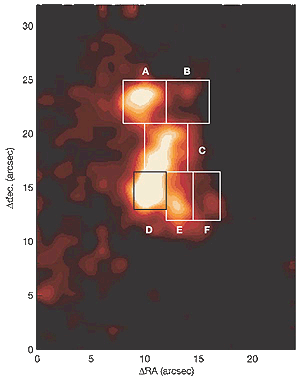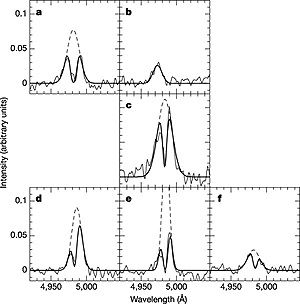 | |||
|
| Home > Public Information > Scientific Highlights > 2005 > The Discovery of a Galaxy-Wide Superwind from a Young Massive Galaxy at Redshift z~3 |
The Discovery of a Galaxy-Wide Superwind from a Young Massive Galaxy at Redshift z 3 3
WHT+SAURON
The formation of galaxies requires gas to cool in haloes of dark matter that
collapse under gravity from the expansion of the Universe. However, cooling alone
overproduces bright galaxies at the present day, so models incorporate thermal conduction, photoionisation
and galaxy merging, together with additional feedback in the form of galactic-scale outflows.
The latter are powered by supernovae and massive stellar winds, or by relativistic
winds and jets resulting from gas accretion onto supermassive black holes. These
high-velocity galactic outflows mark the termination of star formation in the most massive galaxies and
deposit heavy elements in the intergalactic medium.
Although starburst superwinds have been studied in local dwarf galaxies, such as M82, observational evidence for their counterparts in young massive galaxies at high redshift has been less direct: it is unclear whether such outflows are localised to regions of intense star formation just a few kiloparsecs in extent, or whether they instead have a significant impact on the entire galaxy and its surroundings. To observe such outflows via absorption studies a background light source is needed with a spatial extent somewhat larger than a Lyman-break galaxy stellar body or a quasar sightline. Such a source is provided by the recently discovered Lyman-α-emitting blobs (LABs), associated with Lyman-break galaxies in the SSA22 protocluster at redshift z=3.09 (seen 11.5 gigayears ago when the Universe was 20 per cent of its current age), a structure which is likely to evolve into a rich cluster of galaxies. Sizes of these LABs are around 100 kiloparsecs and Lyman-α luminosities of about 1044 erg s-1. The Lyman-α haloes of two of these LABs were observed using integral-field spectroscopy, which, unlike conventional slit spectroscopy, gathers spatially resolved spectra over a two-dimensional area. Such information is essential for a complete picture of the complex morphology of these objects. Astronomers used the SAURON Integral Field Spectrograph on the William Herschel Telescope providing moderate resolution spectroscopy over a 41 arcsec×31 arcsec area, sampled with 0.95-arcsec lenslets. Observations of object LAB-2 shows that its spatially extended Lyman-α line emission appears to be absorbed by neutral hydrogen in a foreground screen covering the entire galaxy, with a lateral extent of at least 100 kiloparsecs (over 300,000 light years across or about three times larger than the disk of our own Milky Way galaxy) and remarkable velocity coherence. Based on the uniformity of the absorption across the galaxy, it appears that this screen was ejected from the galaxy during a starburst several 108 years earlier and has subsequently swept up gas from the surrounding intergalactic medium and cooled. This provides the most direct evidence yet of a galaxy being almost torn apart by the galaxy-wide impact of high-redshift superwinds.
An absorbing shell is predicted to form when a starburst-heated hot gas bubble becomes over-pressurized relative to the interstellar medium and hence breaks out of the galactic disk, accelerates, and fragments as a result of Rayleigh-Taylor instabilities. Hot gas then escapes into the halo and forms a second shell of swept-up intergalactic medium. Evolutionary models for the Lyman-α emission from such superwinds suggest that the LAB-2 absorber is in a late phase, where the shell has cooled and slowed sufficiently to absorb the underlying emission.
Astronomers have long been puzzled about why key elements for the formation of planets and ultimately life (such as carbon, oxygen and iron) are
so widely distributed throughout the Universe; only 2 billion years after the Big Bang, the remotest regions of intergalactic space have
been enriched with them. The superwind observed in this galaxy shows how such blast waves can travel through space carrying the
elements formed deep within galaxies.
|
||||
| Top | Back |
|



